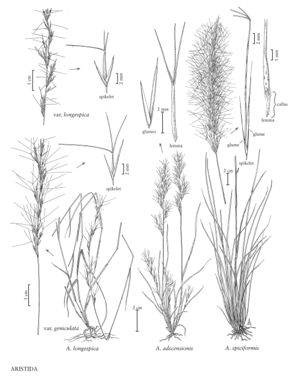Difference between revisions of "Aristida adscensionis"
FNA>Volume Importer |
FNA>Volume Importer |
||
| Line 8: | Line 8: | ||
|name=Aristida interrupta | |name=Aristida interrupta | ||
|authority=unknown | |authority=unknown | ||
| − | }}{{Treatment/ID/Synonym | + | }} {{Treatment/ID/Synonym |
|name=Aristida bromoides | |name=Aristida bromoides | ||
|authority=unknown | |authority=unknown | ||
| − | }}{{Treatment/ID/Synonym | + | }} {{Treatment/ID/Synonym |
|name=Aristida adscensionis var. modesta | |name=Aristida adscensionis var. modesta | ||
|authority=unknown | |authority=unknown | ||
| Line 26: | Line 26: | ||
-->{{Treatment/Body | -->{{Treatment/Body | ||
|distribution=Puerto Rico;Md.;Kans.;Okla.;Colo.;N.Mex.;Tex.;Utah;Calif.;Nebr.;N.Y.;Pacific Islands (Hawaii);Virgin Islands;S.C.;Ariz.;Mo.;Nev. | |distribution=Puerto Rico;Md.;Kans.;Okla.;Colo.;N.Mex.;Tex.;Utah;Calif.;Nebr.;N.Y.;Pacific Islands (Hawaii);Virgin Islands;S.C.;Ariz.;Mo.;Nev. | ||
| − | |discussion=<p>Aristida adscensionis grows in waste ground, along roadsides, and on degraded rangelands and dry hillsides, often in sandy soils. It is associated with woodland, prairie, and desert shrub communities. Its range extends from the United States south through Mexico and Central America to South America.</p><!-- | + | |discussion=<p><i>Aristida adscensionis</i> grows in waste ground, along roadsides, and on degraded rangelands and dry hillsides, often in sandy soils. It is associated with woodland, prairie, and desert shrub communities. Its range extends from the United States south through Mexico and Central America to South America.</p><!-- |
| − | --><p>Because Aristida adscensionis is highly variable in height, panicle size, and awn development, several varieties have been described. None are recognized here because most of the variation appears to be environmentally induced.</p> | + | --><p>Because <i>Aristida adscensionis</i> is highly variable in height, panicle size, and awn development, several varieties have been described. None are recognized here because most of the variation appears to be environmentally induced.</p> |
|tables= | |tables= | ||
|references= | |references= | ||
| Line 48: | Line 48: | ||
|publication year= | |publication year= | ||
|special status= | |special status= | ||
| − | |source xml=https://jpend@bitbucket.org/aafc-mbb/fna-data-curation.git/src/ | + | |source xml=https://jpend@bitbucket.org/aafc-mbb/fna-data-curation.git/src/8f726806613d60c220dc4493de13607dd3150896/coarse_grained_fna_xml/V25/V25_1008.xml |
|subfamily=Poaceae subfam. Aristidoideae | |subfamily=Poaceae subfam. Aristidoideae | ||
|tribe=Poaceae tribe Aristideae | |tribe=Poaceae tribe Aristideae | ||
Revision as of 16:27, 18 September 2019
Plants short- to long-lived annuals. Culms (3)10-50(80) cm, often highly branched above the base. Leaves cauline, glabrous; sheaths shorter than the internodes, not disintegrating into threadlike fibers; ligules 0.4-1 mm; blades 2-14 cm long, 1-2.5 mm wide, flat to involute. Inflorescences panicles, 5-15(20) cm long, 0.5-3 cm wide, often interrupted below; nodes glabrous or with straight, less than 0.5 mm hairs; primary branches 1-4 cm, erect to ascending, without axillary pulvini, with 3-8 spikelets. Spikelets crowded. Glumes unequal, 1-veined, acuminate; lower glumes 4-8 mm; upper glumes 6-11 mm; calluses 0.5-0.8 mm; lemmas 6-9 mm, slightly keeled, midveins scabrous, junction with the awns not evident; awns not disarticulating at maturity, flattened and straight to some¬what curved at the base, central rib flanked by equally wide pale wings; central awns 7-15(20) mm; lateral awns somewhat shorter, occasionally only 1-2 mm; anthers 3, 0.3-0.7 mm. 2n = 22.
Distribution
Puerto Rico, Md., Kans., Okla., Colo., N.Mex., Tex., Utah, Calif., Nebr., N.Y., Pacific Islands (Hawaii), Virgin Islands, S.C., Ariz., Mo., Nev.
Discussion
Aristida adscensionis grows in waste ground, along roadsides, and on degraded rangelands and dry hillsides, often in sandy soils. It is associated with woodland, prairie, and desert shrub communities. Its range extends from the United States south through Mexico and Central America to South America.
Because Aristida adscensionis is highly variable in height, panicle size, and awn development, several varieties have been described. None are recognized here because most of the variation appears to be environmentally induced.
Selected References
None.
